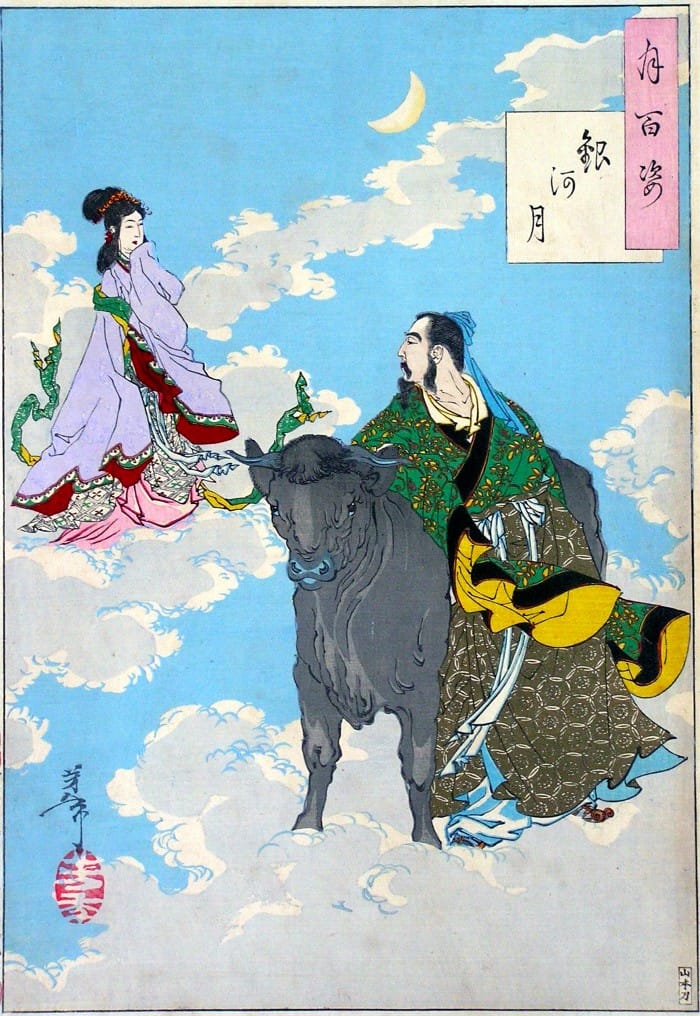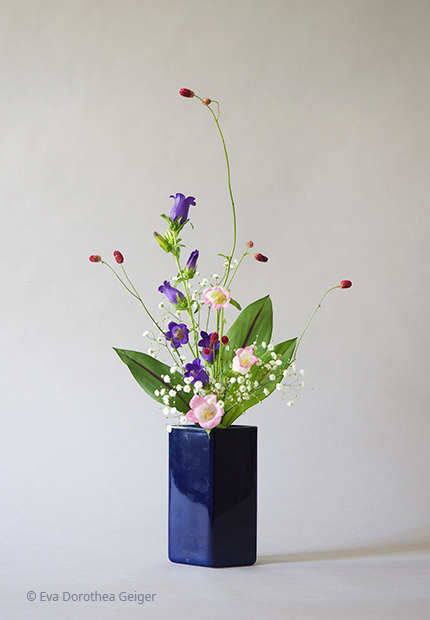
The legend of Tanabata is one of the most famous love stories in Japan and is based on an ancient Chinese myth. It tells the tragic love story of Orihime, the weaver princess, and Hikoboshi, the cowherd.

The beautiful Orihime was the daughter of the sky god Tentei and a talented weaver who spent her days weaving kimonos for the gods at Amanogawa, the river of the sky (the Milky Way). She was so absorbed in her work that there was no time for love in her life. And yet Orihime longed for romance. This longing filled her with despair. Her father Tentei, the King of Heaven, took pity on his beloved daughter. He introduced her to Hikoboshi, a hard-working young cowherd who ruled over the star Altair.
It was the perfect match. Orihime and Hikoboshi fell in love at first sight and spent their days in blissful play - completely neglecting their duties. Soon the gods complained to Tentei about the wretched state of the kimonos and the havoc wreaked by Hikoboshi's cows as they roamed the skies. Tentei was furious at the lovers' carelessness. As punishment, Tentei separated the couple and banished Orihime and Hikoboshi to opposite sides of the Sky River, which separated them from then on.
They returned to their duties, but Orihime's heartbreak made Tentei sad. He couldn't bear to see his daughter cry and explained that if she and Hikoboshi continued to work hard, they would be allowed to see each other once a year - on the night of the 7th day of the 7th month. On that night, a celestial magpie would spread its huge wings and build a bridge across the Milky Way, which Orihime could cross if the sky was clear. If it rained, the river of sky would become too full, making it impossible for Orihime to cross it to meet Hikoboshi.
On this night, people pray for a clear sky so that they can see the Milky Way and imagine the longing meeting of lovers. The rain that falls on the night of 7.7 has a special name Sairuiu, 'the tears of Orihime and Hikoboshi'.

Every year on July 7, people in Japan write their wishes on colorful strips of paper that they hang on bamboo branches in the hope that their wishes will come true, just like the love of Orihime and Hikoboshi. The legend of Tanabata is a beautiful reminder of the power of love and the importance of hard work and dedication.
 Tanabata, the Japanese star festival, an occasion with special symbolic meaning, is also taken up in ikebana on July 7. The colors blue and pink, which are often used in Tanabata ikebana arrangements, carry a profound symbolism and create a harmonious atmosphere that captures the essence of this festival.
Tanabata, the Japanese star festival, an occasion with special symbolic meaning, is also taken up in ikebana on July 7. The colors blue and pink, which are often used in Tanabata ikebana arrangements, carry a profound symbolism and create a harmonious atmosphere that captures the essence of this festival.
In Japanese culture, blue often stands for calm, serenity and depth. It symbolizes the clear night sky under which the two star deities Orihime and Hikoboshi are allowed to meet once a year. In ikebana arrangements, blue is often represented by flowers such as hydrangeas or the Japanese balloon flowers or bluebells, which express the peaceful, dreamy character of the night sky and the longing for a reunion.
Pink, on the other hand, embodies tenderness, love and romance. It is the color that symbolizes the emotional connection between the star-crossed lovers Orihime and Hikoboshi. Pink flowers such as sweet peas, carnations or geraniums are used to represent the tender yet powerful energy of love that is at the heart of the Tanabata festival. Pink also brings a gentle warmth to the arrangement, emphasizing the intensity of feeling that makes this festival so special.
In combination, blue and pink in Tanabata ikebana arrangements create a perfect balance between tranquillity and passion, between the endless waiting and the joyful reunion. This color combination not only expresses the symbolic meaning of the festival, but also creates a visual harmony that immerses the viewer in the mystical and romantic atmosphere of Tanabata.

However, Orihime is often depicted in her femininity with the color pink and Hikoboshi is assigned the color blue, which is considered masculine, while the Milky Way is symbolized by white clouds of flowers in which the two lovers can meet.





